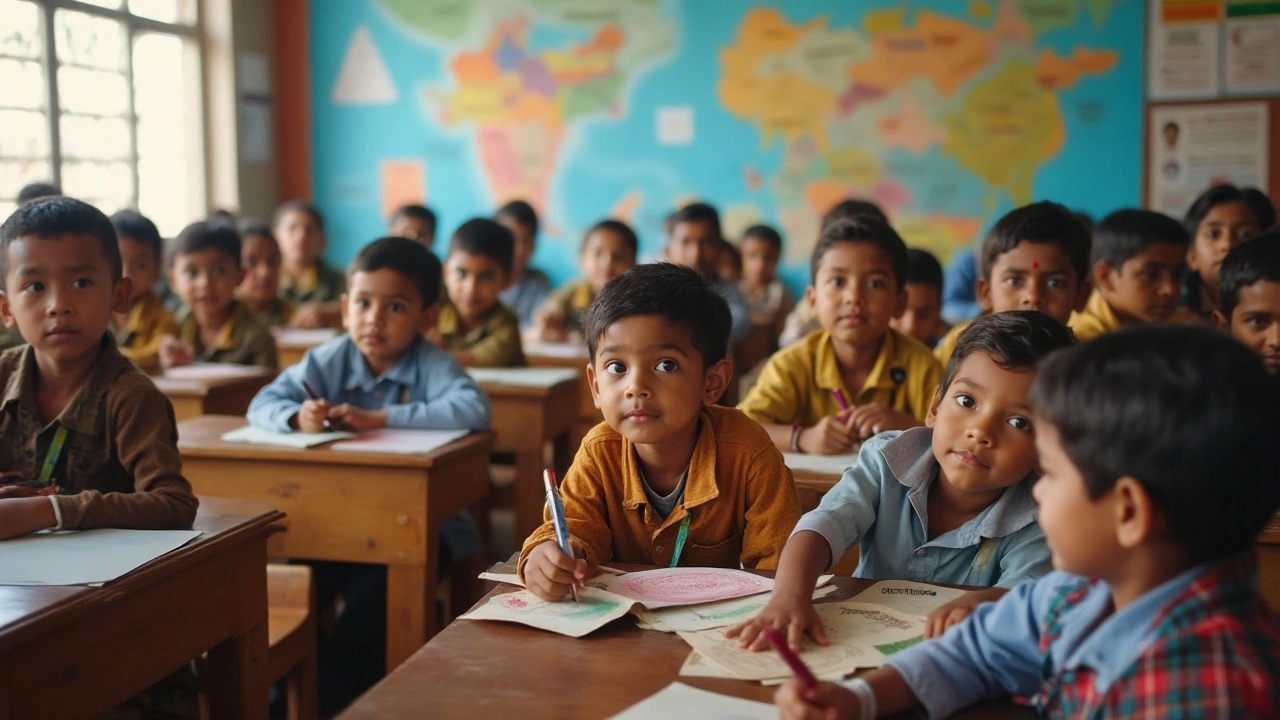The Central Board of Secondary Education (CBSE) often finds itself enveloped in a web of misconceptions, primarily the notion of being a region-bound entity exclusive to Delhi. But peering beyond the veil of assumptions, one discovers an educational titan reaching far beyond the city's borders.
Born in 1929, CBSE's inception was geared towards ensuring fair and standardized education, a goal that now spans the entire nation. While Delhi does play a significant role in its operations, the board's influence permeates through both bustling cities and quiet towns of India.
The reasons for the confusion are manifold, often tangled in historical contexts and administrative decisions. Yet, the truth remains clear – CBSE serves as the educational foundation for millions of students across the country, distinct in its curriculum and approach when set against regional boards.
- Historical Background of CBSE
- CBSE's National Reach
- Why the Misconception Exists
- CBSE vs Regional State Boards
- Impact of CBSE on Indian Education
Historical Background of CBSE
The genesis of the Central Board of Secondary Education (CBSE) is a captivating narrative that spans several decades, transforming the educational landscape of India. Established in 1929, CBSE emerged during the British colonial period, initially known as the 'Uttar Pradesh Board of High School and Intermediate Education'. This organization was responsible for overseeing education across provinces like Rajputana, Central India, and Gwalior. Significantly, its objectives focused on creating a standardized evaluation mechanism, which came in response to the dispersed systems across the nation. This fragmentation made it difficult for educational policies to maintain uniformity, which was increasingly necessary for a nation striving toward independence and modernization.
The pivotal moment for the CBSE's evolution arrived post-independence when India's educational needs underwent drastic changes. In 1952, a major reorganization took place, and CBSE was officially renamed as the Central Board of Secondary Education, indicating its broadened reach and roles. This era marked a paradigm shift in curriculum development and pedagogical strategies, branching away from British influences towards creating a unique Indian identity in education. In this period, CBSE's mandate expanded, and it took under its wing schools from across states that relinquished regional board affiliations in favor of a centralized system.
By the 1960s, CBSE had gained recognition for its structured syllabi and examination methods that emphasized a more holistic approach to learning. This shift can be attributed to its commitment to fostering an environment conducive to comprehensive student development, with syllabi designed not just for academic progress but also moral and social education. An interesting discussion arose in academic circles and was famously noted by a leading educationist of the time:
"CBSE not only provides the knowledge to navigate life but fabricates a moral compass essential for youth in modern India."These words echoed the ethos of CBSE's mission—building a blend of conventional and progressive education traditions.
In ensuing years, CBSE's reach expanded beyond traditional boundaries. By the latter half of the 20th century, it welcomed numerous institutions under its aegis, catering to both national and international students. This expansion was not merely geographical but also ideological, integrating innovative teaching methods and practical exposure for students. As per recent data, the board now affiliates over 24,000 schools globally, a testament to its commitment and adaptability to changing educational dynamics.
Today, CBSE continues to uphold its legacy as a pioneer of quality education. It tirelessly works towards refining its syllabi to include the latest advancements in various fields, while also emphasizing native cultural values. More than a relic of its past, CBSE stands as a beacon that shapes learners who are not just academically proficient but are well-rounded individuals prepared to face global challenges with confidence and creativity.
CBSE's National Reach
The Central Board of Secondary Education (CBSE) boasts a vast educational canvas that paints across the entirety of India, touching lives from the Himalayan foothills to the tropical lands in the south. With its headquarters nestled in the capital of New Delhi, many mistakenly box it into being a 'Delhi board', overshadowing its true span as a national monolith in education. As educational needs evolved post-independence, CBSE emerged as an earnest response to unify and standardize education across states. The overarching aim was to maintain quality, affordability, and accessibility, stepping in where regional disparities existed. It has come a long way since its establishment, becoming one of the most respected education boards globally.
CBSE schools are not just scattered across cities but also penetrate rural landscapes, often serving as the beacon of quality education in areas where educational resources are hard to come by. Today, CBSE affiliates over 27,000 schools within India and approximately 240 schools across 28 foreign countries, testifying to its remarkable reach and acceptance. From Kendriya Vidyalayas to international schools, the CBSE curriculum is often seen as a yardstick for its balanced emphasis on academic rigor and co-curricular growth.
One of the main factors driving its acceptance beyond just urban areas is the alignment of its curriculum with competitive exams such as JEE and NEET, which are gateways to engineering and medical institutions nationwide. This alignment provides students with a distinct advantage, fostering a system where learning is not only about theoretical knowledge but also about practical application. The focus on English as a medium of instruction also increases its appeal, especially when considering future education or career prospects, both domestically and internationally.
Amitav Ghosh, an education expert, notes, "CBSE’s inclusive approach and constant curriculum updating make it relevant for the times, fostering a culture of innovation and critical thinking among students."
Beyond borders, CBSE's inclusive curriculum finds resonance in diverse educational contexts, allowing for seamless student transitions in international settings. This global adaptability can be seen in its growing international footprint, where CBSE schools cater to the Indian diaspora as well as international students interested in Indian culture and educational methodologies.
The ability to integrate and respect local cultures while maintaining a universal standard has been key to CBSE's sustained growth and acceptance. This is complemented by its robust teacher training initiatives, ensuring educators are well-equipped to deliver education effectively in various settings. As we move towards an era of hybrid learning models, CBSE's forward-thinking policies related to digital learning provide a template for achieving a future-ready education system.

Why the Misconception Exists
The origins of the misconception that the CBSE is a
CBSE vs Regional State Boards
The educational landscape in India is incredibly diverse, comprising multiple boards that govern how students are taught. Among these, the CBSE stands out due to its national footprint, contrasting sharply with regional state boards that cater to specific states. Each has its unique attributes, methodologies, and impacts on student outcomes. Understanding these differences is crucial for comprehending the broader educational dynamics in India.
One major distinction between CBSE and state boards lies in their curriculum structure. CBSE follows a syllabus that is more aligned with national entrance examinations such as the IIT-JEE or NEET. This approach is designed to provide a comprehensive foundation that helps students compete on a national level. On the other hand, state boards often focus on region-specific content, including local languages and cultures, which may not always correlate directly with national competitive exams.
The language of instruction also varies significantly between CBSE and state boards. While CBSE typically emphasizes English as the primary medium, fostering a more global outlook, state boards often provide instructions in the regional language, which can enhance understanding of local traditions and knowledge. This linguistic diversity can influence the ease with which students transition to higher education or professional environments outside their home states. A well-rounded education system supports both cultural heritage and global competitiveness, which can be a topic of education policy debates.
Quality of education remains a dividing factor, with many perceiving CBSE as more consistent due to its uniform standards across the country. A student in Delhi receives the same quality of education as one in Kerala or Assam, under the aegis of CBSE. This standardization can offer significant advantages, such as the ability to evaluate and benchmark performance uniformly across diverse geographies. However, it also means that certain local educational advantages may be less emphasized in CBSE curricula.
State boards are fundamentally important for promoting regional identities and addressing local educational needs. Their syllabi often include regional history and literature, which are pivotal for maintaining cultural identity. These synergies between education and culture present an interesting dichotomy, where students are inculcated with a strong sense of local heritage. These boards also play a vital role in regional governance of education, adapting policies to meet specific demographic needs.
To illuminate these differences, consider this viewpoint shared by an educational analyst:
"While state boards celebrate regional diversity, CBSE acts as a unifying thread, binding the vast educational tapestry of India into a cohesive academic narrative."This encapsulates the balance each system strives to achieve—one of global readiness and another of cultural richness. It's the blend of these elements that often sparks a lifelong love for learning among students.

Impact of CBSE on Indian Education
The landscape of Indian education has been immensely shaped by the Central Board of Secondary Education, influencing not only urban sectors but also rural pockets of the country. CBSE's curriculum is lauded for its comprehensive approach, merging theoretical knowledge with practical application, a balance sought by many students and parents alike. This approach empowers learners with a solid foundation in core subjects like mathematics and science, while also promoting arts and humanities, ensuring a well-rounded education. The board emphasizes on holistic development, which includes co-curricular activities, giving students avenues to explore their interests beyond academics.
One significant impact of CBSE is its penetration into educational policies, advocating for a shift towards continuous and comprehensive evaluation (CCE) over the traditional examination system. This method encourages regular assessments over rote learning, encouraging learners to grasp concepts thoroughly rather than memorizing details for a single exam. According to a report by the Ministry of Human Resource Development, CBSE schools have shown higher performance metrics when compared to non-CBSE institutions, a testament to its successful strategies. The board's insistence on maintaining academic standards has also set benchmarks for other educational boards to aspire to.
CBSE has also played a remarkable role in ensuring that educational resources reach far-flung areas. Through initiatives like digital learning platforms and remote study programs, the board has endeavored to bridge the educational divide between urban and rural sectors. In 2022, CBSE introduced a policy to integrate gifted education programs, further tailoring its resources to accommodate diverse student needs. This inclusivity does not merely end with geographical reach; CBSE supports students with special needs with customized resources to ensure equitable access to quality education.
As noted by Mr. Ramesh Pokhriyal, former Union Education Minister, "CBSE goes beyond textbooks, teaching students to connect learning with their lives, ultimately transforming India into a global knowledge hub."
The focus on competitive exams is another facet where CBSE leaves its mark. The CBSE curriculum is considered a stepping stone for national entrance examinations like the JEE (Joint Entrance Examination) and NEET (National Eligibility cum Entrance Test). This is due to its emphasis on problem-solving and critical thinking, skills that are indispensable for such competitive fields. Additionally, CBSE ensures continuous revision of its syllabus to accommodate the evolving trends in education and technology, keeping Indian students on par with global standards.
Moreover, CBSE's association with various international educational bodies has introduced modern pedagogical practices into its syllabus, aligning it with international educational standards. By fostering such collaborations, it aims to prepare students for global opportunities. Schools affiliated with CBSE enjoy a reputation of credibility and quality, thus attracting expatriate families and further diversifying the student body, enriching the educational experience. The board's methodology has reshaped how education is perceived, moving away from textbook-centric learning to nurturing critical thinkers prepared to face a rapidly changing global scenario.
